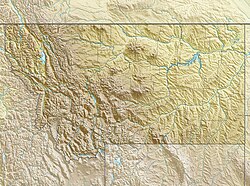1959 Hebgen Lake earthquake
| Date | August 17, 1959 |
|---|---|
| Magnitude | 7.3–7.5 Mw |
| Epicenter |
44°51′47″N 111°20′06″W / 44.863°N 111.335°WCoordinates: 44°51′47″N 111°20′06″W / 44.863°N 111.335°W ~15 miles North of West Yellowstone, Montana, United States |
| Type | Dip-slip |
| Areas affected | southwestern Montana, Idaho, Wyoming |
| Casualties | 28+ dead |
The 1959 Hebgen Lake earthquake also known as the 1959 Yellowstone earthquake occurred on August 17 at 11:37 pm (MST) in southwestern Montana, United States. The earthquake measured 7.3 – 7.5 on the Richter magnitude scale, and caused a huge landslide that caused over 28 fatalities and left $11 million (1959 US$, $88.7 million 2014 US$) in damage. The slide blocked the flow of the Madison River resulting in the creation of Quake Lake. Effects of the earthquake were also felt in Idaho and Wyoming.
The 1959 quake was the strongest and deadliest earthquake to hit Montana since the 1935-36 Helena earthquakes left 4 people dead. It also caused the worst landslides in the history of the Northwestern United States since 1927.
The earthquake occurred at 11:37 p.m. (mst) with a Richter magnitude estimated between 7.3 and 7.5. The U.S. Weather Bureau reported that the quake lasted 30–40 seconds. During the earthquake the surrounding landscape dropped as much as 20 feet (6 m) and shockwaves caused numerous seiches to surge across Hebgen Lake for 12 hours. Water pushed by the seiches poured over the dam which did not collapse. Several aftershocks ranging from 5.8 to 6.3 were reported after the quake.
The earthquake struck in Madison Canyon, an area to the west of Yellowstone National Park. Several nearby campgrounds were occupied by vacationing campers and tourists at the time the quake struck.
Although magnitude measurements of the 1959 earthquake vary (the United States Geological Survey recorded the quake at both 7.3 and 7.5 on the Richter magnitude scale, while other seismographs recorded the quake at 7.8), the 1959 earthquake is comparable to the 1906 San Francisco earthquake as one of the strongest earthquakes in North America, behind the 1964 magnitude 9.2 Good Friday earthquake in Alaska. The 1959 earthquake is also the most severe earthquake in the Rocky Mountain area of the United States along with the 7.3 magnitude earthquake which struck Idaho in 1983. The landslide caused by quake was the largest since an earthquake in Wyoming in 1925 caused a landslide amounting to 50,000,000 cubic yards (38,000,000 m3) of rock and debris that left 28 people dead. The death toll from the quake was also the highest since the 1925 earthquake and most recent for the Northwestern United States since an earthquake in 1927 that left seven people dead. The 1959 earthquake was also the most damaging earthquake to occur in Montana since the 1935-36 earthquakes that left four people dead. The Hebgen Lake area also experienced earthquakes again in 1964, 1974, 1977 and 1985.
...
Wikipedia

